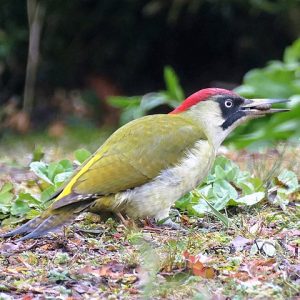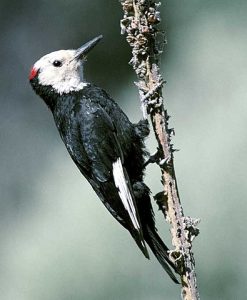Podcast: Play in new window | Download (Duration: 10:33 — 11.6MB)
Thanks to Joel and Mary for suggesting some really interesting woodpeckers this week!
Further watching:
Rare woodpecker thought extinct spotted in Ohio
The green woodpecker really likes to eat ants [picture by Remyymer – Own work, CC BY-SA 4.0, https://commons.wikimedia.org/w/index.php?curid=65008314]:

The white-headed woodpecker looks like its face got splashed with paint:

The red-headed woodpecker has the prettiest shade of red [picture by colleen – originally posted to Flickr as Red Headed Woodpecker, CC BY-SA 2.0, https://commons.wikimedia.org/w/index.php?curid=6639146]:

The acorn woodpecker looks like it got its face splashed with white paint and then dipped its beak in black paint [picture by Charles J. Sharp – Own work, from Sharp Photography, sharpphotography.co.uk, CC BY-SA 4.0, https://commons.wikimedia.org/w/index.php?curid=136903489]:

Show transcript:
Welcome to Strange Animals Podcast. I’m your host, Kate Shaw.
This week we’re going to talk about a type of bird that several people have suggested, the woodpecker! Thanks to Joel and Mary for their suggestions, and I could swear someone else suggested woodpeckers a while back. If that was you, thank you and I’m sorry I didn’t write it down!
It’s funny that we haven’t talked about woodpeckers very often, because they are definitely strange animals. How many animals use their head to hammer holes in wood? The woodpecker has a strong, heavy bill that it uses to drill holes in trees to find hidden insects and other invertebrates. A lot of insects dig little burrows in wood, and the woodpecker hammers away at the wood until it exposes the burrow. Then it has to get the insect or grub out of the burrow without it getting away, so it has a long, sticky tongue with barbs at the end. It can stick its tongue into the burrow and use it to drag the insect out and eat it.
When I say woodpeckers have long tongues, I mean their tongues are way longer than you think. The woodpecker’s skull contains a special cavity that wraps all the way around the brain and back down to the right nostril, and this cavity is where the main part of the tongue is when the woodpecker isn’t actually using it. It also helps cushion the brain and keep it from moving too much while the woodpecker is pecking. The skull itself is lined with spongy bone to soften impacts too.
The woodpecker also has a lot of other adaptations to using its entire head like a hammer. To protect its eyes from debris and pressure damage, it has a thick membrane that it uses to cover the eye, like built-in safety goggles. It has tiny, tough feathers that protect the nostrils from debris, and its nostrils are usually very small and thin too. Even its skin is thicker than that of most birds.
Woodpeckers have weird feet too. Almost all species have four toes, two that point forward, two that point backward. This arrangement is called zygodactyly, and it’s a trait also found in parrots and some other birds, and in chameleons. It allows the woodpecker to climb trees and branches securely and easily. The woodpecker also has a relatively short tail with stiff feathers that it uses to prop itself up against a tree trunk while hammering.
The woodpecker doesn’t just use its hammering ability to find food. It also hammers to communicate with other woodpeckers, the same way other birds use song. Each species has its own pattern of drumming, and the sound can attract a mate or tell rivals that this territory is already taken. When it’s communicating, the woodpecker will drum on different surfaces than when it’s just looking for food. This might be a hollow tree that amplifies the sound, or even an artificial surface. The first time I observed this as a birdwatcher was when I noticed a red-breasted woodpecker hammering repeatedly on a metal light post.
Woodpeckers do make ordinary sounds, though. Mary suggested the European green woodpecker and pointed out that its old name is yaffle, which mimics its call. This is what the green woodpecker sounds like:
[green woodpecker call]
Birders still refer to the sound as yaffling, which is the funniest word I’ve said all day.
The green woodpecker is native to much of Europe and parts of Asia. It has a bright red head and a black mask on its face, and its body is mostly an olive green color with a yellow rump patch. It’s a large bird, with a wingspan up to 20 inches across, or 51 cm. It especially likes to eat ants and spends most of its time on the ground looking for them. When it finds an ant nest, it will use its bill to open the nest up and then it licks up all the yummy ants and larvae with its long sticky tongue. As an example of how long a woodpecker’s tongue is, the green woodpecker has a tongue 4 inches long, or 10 cm, while its entire body is 14 inches long, or 36 cm.
Unlike most woodpeckers, the green woodpecker doesn’t do a lot of drumming or woodpecking. When it does, it’s mostly on very soft or rotten wood, and it’s probably not looking for food but excavating a nest hole to lay eggs in. Its favorite habitat is open woodland, since it can nest and hide in the trees but find lots of ants on the ground.
Joel suggested we learn about the white-headed woodpecker. I’d never heard of that one before, probably because it only lives in mountainous pine forests in parts of the Pacific northwest of Canada and the United States. It’s a glossy black in color with a mostly white head and a streak of bright white on its wings. Males have a red head patch too. It mostly eats pine seeds, which are found in pine cones. The seeds are quite large and the white-headed woodpecker is relatively small, only about 9 inches long, or 23 cm.
It will take a pine seed, wedge it into a crevice in a tree, and break it into bite-sized pieces by hammering it. It also eats insects, but it mainly finds them under the bark of trees, and it will sometimes peck little holes into tree trunks and eat the sap that oozes out. Unlike pretty much every woodpecker known, the white-headed woodpecker’s tongue isn’t especially long, probably because it doesn’t need a long tongue to find pine seeds.
This is what the white-headed woodpecker sounds like:
[white-headed woodpecker call]
One of my favorite birds is the red-headed woodpecker, which has a vibrantly red head and a black and white body that almost looks checkered. It’s native to North America and lives year-round in much of the eastern and central United States, but for some reason it took me years as a birdwatcher before I saw one for the first time. I didn’t know just how beautiful it really is until I saw one in person. Red is my favorite color, and the red-headed woodpecker’s red head is my exact favorite shade of red.
The red-headed woodpecker is about the size of the white-headed woodpecker, or a little larger. It eats lots of insects but will also eat seeds, berries and other fruit, and even the eggs of other birds. It sometimes catches insects on the wing. It’s also one of only a few species of woodpecker that stores food, hiding it in crevices in trees or under the shingles of people’s houses. Occasionally when it catches too many grasshoppers to eat, it will wedge the living grasshoppers in crevices so tightly that the insect is stuck there until the bird comes back when it’s hungry. That’s disturbing.
Another bird that caches food is the acorn woodpecker, which lives in parts of southwestern North America down through Central America. It’s mostly black with white patches on the face and black and white streaks underneath. Males have a red patch on the back of the head too. As you probably guessed from its name, it eats a lot of acorns along with insects, fruit, and tree sap. Because acorns are seasonal foods, only available in the fall, the acorn woodpecker stores acorns to eat later in the year. It hides the acorns in holes and crevices, often pecking little holes in a tree specifically for storage, but as the acorns dry out they take up less space. The bird spends a lot of time throughout the year moving its acorns to better hiding spaces.
The acorn woodpecker lives in small flocks of up to about a dozen or 15 birds. All birds in the flock help raise any babies, and in years where there aren’t very many acorns, only a few of the females in the group will lay eggs. In years where there are lots of acorns, all of the females will usually lay eggs. They all lay their eggs in the same nesting cavity and the babies are raised together.
So why do so many woodpeckers have such bright colors and markings? Many are black and white, often with red or yellow markings on the head or neck. They look conspicuous to us, but the black and white patterning blends in with the pattern of light and shadow under trees. The bright spots of color help attract mates, since a bird with brightly colored feathers shows other birds that they’re healthy. In many species, only the male has a red patch, or the female’s red patch may be smaller than the male’s.
Way back in episode 9 we talked about the ivory-billed woodpecker and some of its close relations. The ivory-billed woodpecker was thought to be extinct but possible sightings and audio recordings indicate it may still be alive in remote areas of the southeastern United States. Most recently, video footage of a bird spotted in Ohio has the controversy starting up again. I’ve linked to the video in the show notes. The bird in the video is probably just the very similar-looking pileated woodpecker, but the light isn’t good so it’s hard to tell for sure. It’s just barely possible it might actually be an ivory-billed woodpecker. Let’s hope it is an ivory-billed.
You can find Strange Animals Podcast at strangeanimalspodcast.blubrry.net. That’s blueberry without any E’s. If you have questions, comments, or suggestions for future episodes, email us at strangeanimalspodcast@gmail.com. We also have a Patreon at patreon.com/strangeanimalspodcast if you’d like to support us for as little as one dollar a month and get monthly bonus episodes.
Thanks for listening!